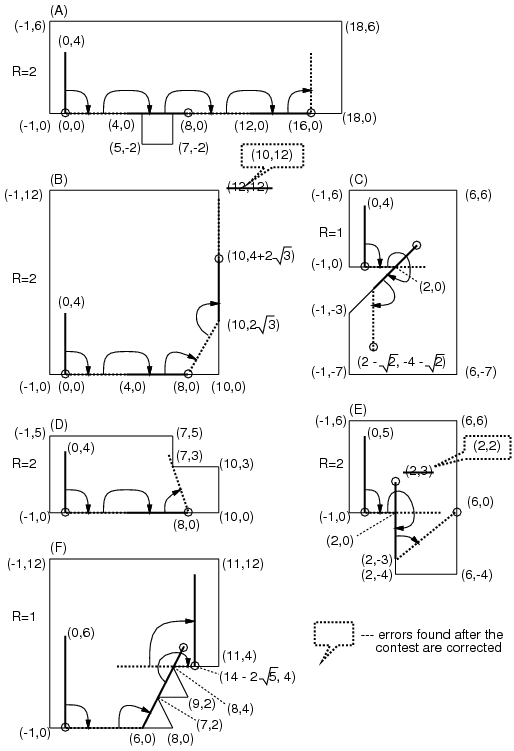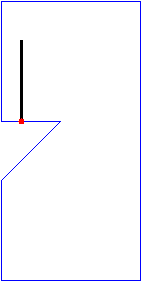81 . Twirl Around
Description
Let's think about a bar rotating clockwise as if it were a twirling baton moving on a planar surface surrounded by a polygonal wall (see Figure 1).
Figure 1. A bar rotating in a polygon
Initially, an end of the bar (called "end A") is at (0,0), and the other end (called "end B") is at (0,L) where L is the length of the bar. Initially, the bar is touching the wall only at the end A.
The bar turns fixing a touching point as the center. The center changes as a new point touches the wall.
Your task is to calculate the coordinates of the end A when the bar has fully turned by the given count R.

Figure 2. Examples of turning bars
In Figure 2, some examples are shown. In cases (D) and (E), the bar is stuck prematurely (cannot rotate clockwise anymore with any point touching the wall as the center) before R rotations. In such cases, you should answer the coordinates of the end A in that (stuck) position.
You can assume the following:
When the bar's length L changes by ε (|ε| <
0.00001), the final (x,y) coordinates
will not change more than 0.0005.
Input Format
The input consists of multiple datasets. The end of the input is represented by "0 0 0".
The format of each dataset is as follows:
L R N X1 Y1 X2 Y2 ... XN YN
L is the length of the bar. The bar rotates 2π× R radians (if it is not stuck prematurely). N is the number of vertices which make the polygon.
The vertices of the polygon are arranged in a counter-clockwise order. You may assume that the polygon is simple, that is, its border never crosses or touches itself.
N, Xi and Yi are integer numbers; R and L are decimal fractions. Ranges of those values are as follows:
1.0 ≤ L ≤ 500.0, 1.0 ≤ R ≤ 10.0, 3 ≤ N ≤ 100, -1000 ≤ Xi ≤ 1000, -1000 ≤ Yi ≤ 1000,
X1 ≤ -1, Y1 = 0,
X2 ≥ 1, Y2 = 0.
Output Format
For each dataset, print one line containing x- and
y-coordinates of the final position of the end A,
separated by a space.
The value may contain an error less than or equal to 0.001.
You may print any number of digits after the decimal point.
四捨五入到小數點後六位 因為解答這樣寫= =
Sample Input 1
4.0 2.0 8 -1 0 5 0 5 -2 7 -2 7 0 18 0 18 6 -1 6 4.0 2.0 4 -1 0 10 0 10 12 -1 12 4.0 1.0 7 -1 0 2 0 -1 -3 -1 -8 6 -8 6 6 -1 6 4.0 2.0 6 -1 0 10 0 10 3 7 3 7 5 -1 5 5.0 2.0 6 -1 0 2 0 2 -4 6 -4 6 6 -1 6 6.0 1.0 8 -1 0 8 0 7 2 9 2 8 4 11 4 11 12 -1 12 0 0 0
Sample Output 1
16.000000 0.000000 10.000000 7.464102 0.585786 -5.414214 8.000000 0.000000 6.000000 0.000000 9.527864 4.000000
Hints
Note that the above sample input corresponds to the cases in Figure 2. For convenience, in Figure 3, we will show an animation and corresponding photographic playback for the case (C).

Figure 3. Animation and photographic playback for case (C)
Info: 本題輸出為浮點數,絕對或相對誤差 1e-3 以下視為正確
Problem Source
Migrated from old NTUJ.
Subtasks
| No. | Testdata Range | Score |
|---|
